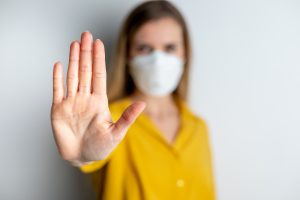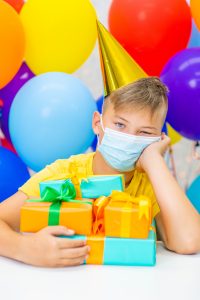Many countries have made it law that in certain environments, such as public transport, that people must wear face masks to protect against the novel coronavirus, SARS-CoV-2. How beneficial is this in protecting you? Are there health risks in doing so?
In a World Health Organisation (WHO) funded study, published in The Lancet 1)D. Chu et al. (2020) Physical distancing, face masks, and eye protection to prevent person-to-person transmission of SARS-CoV-2 and COVID-19: a systematic review and meta-analysis, The Lancet, VOLUME 395, ISSUE 10242, P1973-1987, JUNE 27, 2020, DOI: https://doi.org/10.1016/S0140-6736(20)31142-9, it was found there was low certainty in whether face masks protect against spreading of the SARS-CoV-2 coronavirus. The article states that wearing a high-grade surgical face mask (such as R95) could result in a reduction in risk of infection. Wearing face masks in clinical i.e. medical settings is normal practice for medical staff performing procedures, such as dentists and dental nurses, and in hospitals such as in operating theatres. Or in doctors’ surgeries where a medical procedure such as minor surgery is being performed. Medical professionals wear face masks in these settings to avoid ingesting splatter from patient blood.
The WHO, in its advice on wearing for COVID-19 face masks2)World Health Organisation (5 June 2020), Advice on the use of masks in the context of COVID-19, https://www.who.int/publications/i/item/advice-on-the-use-of-masks-in-the-community-during-home-care-and-in-healthcare-settings-in-the-context-of-the-novel-coronavirus-(2019-ncov)-outbreak, states for the general public in community settings:
At present, there is no direct evidence (from studies on COVID-19 and in healthy people in the community) on the effectiveness of universal masking of healthy people in the community to prevent infection with respiratory viruses, including COVID-19.” [Ref 2, p6]
So why are we being told to wear face masks? One reason is that there is weak evidence that someone who is symptomatic of flu (actually coughing and sneezing) but wears a surgical face mask is less likely to spread the flu. In Asian countries, this is a common sight.
In nations where people are being encouraged to make their own masks, there is no evidence this is protective at all3)World Health Organisation (5 June 2020), Advice on the use of masks in the context of COVID-19, https://www.who.int/publications/i/item/advice-on-the-use-of-masks-in-the-community-during-home-care-and-in-healthcare-settings-in-the-context-of-the-novel-coronavirus-(2019-ncov)-outbreak. It is only high-grade surgical masks that offer any protection and only for a short period of time. Indeed, wearing a face mask for a long period of time increases the risk of a viral infection because of the damp, warm patch in front of the mouth and nose. This is ideal breeding grounds for microorganisms such as viruses!
“For the average person walking down the street, wearing a face mask is not a good idea,” UK Deputy Chief Medical Officer, Julie Harries, because the face mask “could trap the virus inside the mask and breathe it in.”4)The Independent, Coronavirus: Face masks could increase risk of infection, medical chief warns, 12 March 2020 https://www.independent.co.uk/news/health/coronavirus-news-face-masks-increase-risk-infection-doctor-jenny-harries-a9396811.html
A randomised control trial conducted in Denmark with 6000 participants conducted in April and May 2020 found there was no significant difference between the people wearing masks and those not wearing masking in contracting SARS-CoV-2, with 1.8% of those wearing masks testing positive (PCR test) against 2.1%. The study’s conclusion was that mask wearing does not aid in reducing the risk of catching the SARS-CoV-2 virus.5)Bundgaard H. et al. (18 Nov 2020), Effectiveness of Adding a Mask Recommendation to Other Public Health Measures to Prevent SARS-CoV-2 Infection in Danish Mask Wearers, Annals of Internal Medicine, https://doi.org/10.7326/M20-6817 This conclusion supports findings that face masks do not protect people from respiratory viruses in general6)Jefferson, T., Jones, M., Al Ansari, L.A., Bawazeer, G., Beller, E., Clark, et al., 2020. Physical interventions to interrupt or reduce the spread of respiratory viruses. Part 1 – Face masks, eye protection and person distancing: systematic review and meta-analysis. MedRxiv. [preprint]. (https://www.medrxiv.org/content/10.1101/2020.03.30.20047217v2, accessed 4 June 2020.
The World Health Organisation 2states a key benefit of wearing a mask, other than making people feel they are part of the solution in not spreading the coronavirus, is:
“reminding people to be compliant with other measures (e.g., hand hygiene, not touching nose and mouth)” [ref 2, p8].
Is this the heart of it: people being trained to be compliant to the declarations of the WHO and their government – such as, the on-going media campaign declaring only a vaccine will halt the pandemic and that mandatory vaccination is the only path to guaranteeing this? Vaccinations are not the solution to pandemics!
According to the WHO, the disadvantages of wearing face masks to healthy people in the general public include:
- “potential increased risk of self-contamination due to the manipulation of a face mask and subsequently touching eyes with contaminated hands;7)Zamora JE, Murdoch J, Simchison B, Day AG. Contamination: a comparison of 2 personal protective systems. CMAJ. 2006;175(3):249-54. 8)Kwon JH, Burnham CD, Reske KA, Liang SY, Hink T, Wallace MA, et al. Assessment of Healthcare Worker Protocol Deviations and Self-Contamination During Personal Protective Equipment Donning and Doffing. Infect Control Hosp Epidemiol. 2017;38(9):1077-83.
- potential self-contamination that can occur if non-medical masks are not changed when wet or soiled. This can create favourable conditions for microorganism to amplify;
- potential headache and/or breathing difficulties, depending on type of mask used;
- potential development of facial skin lesions, irritant dermatitis or worsening acne, when used frequently for long hours;9)Al Badri F. Surgical mask contact dermatitis and epidemiology of contact dermatitis in healthcare workers. Current Allergy & Clinical Immunology, 30,3: 183 – 188. 2017.
- difficulty with communicating clearly;
- potential discomfort;10) Jefferson, T., Jones, M., Al Ansari, L.A., Bawazeer, G., Beller, E., Clark, et al., 2020. Physical interventions to interrupt or reduce the spread of respiratory viruses. Part 1 – Face masks, eye protection and person distancing: systematic review and meta-analysis. MedRxiv. [preprint]. (https://www.medrxiv.org/content/10.1101/2020.03.30.20047217v2, accessed 4 June 2020 11)Matusiak L, Szepietowska M, Krajewski P, Bialynicki-Birula R, Szepietowski JC. Inconveniences due to the use of face masks during the COVID-19 pandemic: a survey study of 876 young people. Dermatol Ther. 2020.
- a false sense of security, leading to potentially lower adherence to other critical preventive measures such as physical distancing and hand hygiene;
- poor compliance with mask wearing, in particular by young children;
- waste management issues; improper mask disposal leading to increased litter in public places, risk of contamination to street cleaners and environment hazard;
- difficulty communicating for deaf persons who rely on lip reading;
- disadvantages for or difficulty wearing them, especially for children, developmentally challenged persons, those with mental illness, elderly persons with cognitive impairment, those with asthma or chronic respiratory or breathing problems, those who have had facial trauma or recent oral maxillofacial surgery, and those living in hot and humid environments.” [2, p8]
The only potential medical benefit of the use of masks by healthy people in the general public listed by the WHO is the “reduced potential exposure risk from infected persons before they develop symptoms.”[2, p7].This sentence is very carefully worded. Potential exposure does not mean actual exposure. How do you know someone has SARS-CoV-2 prior to development of symptoms? The deliberate implication is that people should always wear a mask out of fear that your neighbour on a train, for instance, has SARS-CoV-2, even though he or she is displaying no symptoms whatsoever.

The actual documented evidence that asymptomatic people (those not displaying symptoms) spread coronavirus is almost non-existent.
A study published in Respiratory Medicine12)M. Gao et al. 2020. A study on infectivity of asymptomatic SARS-CoV-2 carriers, Respir Med. 2020 Aug; 169: 106026 https://www.ncbi.nlm.nih.gov/pmc/articles/PMC7219423/ of 455 asymptomatic SARS-CoV-2 carriers, isolated for 4-5 days, found there was zero infectivity of family members or medical staff. The paper concludes in its discussion:
“we conclude that the infectivity of some asymptomatic SARS-CoV-2 carriers might be weak. This finding implicates that there is not needful to worry unduly for asymptomatic or mild patients during the ongoing COVID-19 pandemic.” 13)M. Gao et al. 2020. A study on infectivity of asymptomatic SARS-CoV-2 carriers, Respir Med. 2020 Aug; 169: 106026 https://www.ncbi.nlm.nih.gov/pmc/articles/PMC7219423/
A different study found 10 per cent transmission in households but that the secondary cases were milder than the primary (hence, those transmitting were not asymptomatic) 14)L. Luo et al. (2020) Modes of contact and risk of transmission in COVID-19 among close contacts, medRxiv, doi: https://doi.org/10.1101/2020.03.24.20042606 (preprint. A study in South Korea reports of a cohort of 97 infected people, where follow ups with ‘track and trace’ of 17 families found no secondary transmission15)Park S, Kim Y, Yi S, Lee S, Na B, Kim C, et al. Coronavirus Disease Outbreak in Call Center, South Korea. Emerg Infect Dis. 2020;26(8):1666-1670. https://dx.doi.org/10.3201/eid2608.201274. A meta-analysis of four published studies found that the infection rate from asymptomatic people ranged from 0 – 2.2%. Symptomatic transmission rates ranged from approx. 1 -15%16)O. Byambasuren et al. (2020) Estimating the extent of asymptomatic COVID-19 and its potential for community transmission: systematic review and meta-analysis, medRxiv doi: https://doi.org/10.1101/2020.05.10.20097543. This is clearly indicative that those people who are healthy and display no outward signs of SARS-CoV-2 are extremely unlikely to spread the virus.
The implications for wearing a face mask: it is only if an individual has greater than mild symptoms of SARS-CoV-2 that healthy individuals should wear a face mask. Those who have known co-morbidities such as cancer or a chronic disease not in remission should wear a mask around people who are displaying symptoms of SARS-CoV-2. However, this should not be a long-term arrangement because of oxygen depletion from wearing a mask can have negative effects on the body.
As the WHO points out, wearing a face mask can cause breathing difficulties. These include hypoxia, where the body is deprived of adequate oxygen supply. Lack of oxygen can lead to cancer and other chronic diseases. If you are suffering from one, then it is vital to get as much oxygen into your system as possible17)Toru Abo, The Only Two Causes of All Diseases, Babel Corporation (8 April 2013).. Those who have asthma would be greatly affected by having to wear a face mask18)Adebayo Folorunsho-Francis (17 May 2020), Wearing face masks exposes asthmatics to hypoxia — Physicians, The Punch https://www.msn.com/en-xl/news/other/wearing-face-masks-exposes-asthmatics-to-hypoxia-physicians/ar-BB14bVrt, as pointed out by the WHO. There is also a risk of hypercapnia, where there is too much carbon dioxide in the blood. Face masks could make this possible by trapping exhaled carbon dioxide between the face and mask. Inhaling could lead to increased levels of CO2. This could result in drowsiness, dizziness, fatigue, headaches19)Matuschek C. et al (2020) Face masks: benefits and risks during the COVID-19 crisis, European Journal of Medical Research 25 (32), https://link.springer.com/article/10.1186/s40001-020-00430-5. The evidence on hypercapnia is weak especially since COVID-19, unless you suffer from a pulmonary problem such as chronic obstructive pulmonary disease (COPD). Wearing a face mask with COPD can result in hypercapnia..
The excessive wearing of face masks can lead to health side effects. There is little convincing evidence face masks offer significant protection against SARS-CoV-2 except in the close vicinity of someone displaying moderate or severe symptoms. Only high-grade medical face masks would work in this instance, and only for a short period of time. Homemade face masks offer no protection. It is equivalent of trying to stop a grain of sand (SARS-CoV-2 molecule) from falling through of a chicken wire fence (homemade mask).

The psychological effect of wearing a face mask is negative. Primarily, face masks have been associated, at least in the western world, with suspicious activity. We view people with face coverings having something to hide. Our world view of face masks is now changed. Communication breakdown is now more common. People rely on understanding facial expression and that means being able to see the whole face. Those who need to lip read no longer feel they can communicate with people. The impact on children has been shocking. In many countries, children have been forced to wear face masks even whilst playing sport in school or singing. Yet all the statistics show that children are by far the least likely group to catch COVID-19, to get sick from it or to pass it on. The wearing of face masks in such circumstances is very cruel. No medical evidence supports this draconian action. Breathing through a face mask can feel like hard work. This is because we tend to breathe through an open mouth and only engage our upper chest muscles. This is highly inefficient and can cause anxiety and stress20)Children’s Minnesota, Breathing tips and mindfulness while wearing a mask, https://www.childrensmn.org/2020/07/15/breathing-tips-while-wearing-mask/. Mouth breathing can have adverse effects on children’s facial growth, causing facial deformities, sleep problems, negative affect academic performance and cause behavioural problems21)Jefferson, Y. (2010), Mouth breathing: adverse effects on facial growth, health, academics, and behaviour, Gen Dent, Jan-Feb 2010;58(1):18-25; quiz 26-7, 79-80..
In a German-language study of the psychological impact of wearing face coverings with over 1000 participants, it was found that “approximately 60% of people feeling clearly burdened by the regulations already experience heavy (psychosocial) consequences, such as strongly reduced participation in social life due to mouth-nose-protection avoidance efforts caused through aversion, social retreat, reduced health self-care (up to the avoidance of physician appointments) or the reinforcement of pre-existing health problems (post-traumatic stress disorders, herpes, migraine), exceeded all expectations of the examiner.” And that, “The degree of stress felt when wearing the mouth-nose-protection builds, in many cases, the degree of psycho-vegetative stress reactions and after-effects through internally increasing aggression, which is highly relevant to health (and, with aggression, to society). (In others) Through an impaired self- and body-experience this also clears the way for an indirect depressive self-experience.” The author of the study also describes a psychologically degenerative state meaning “that a large proportion of those affected are at least on the threshold of traumatization.”22)Prousa, D. (2020). Study on psychological and psycho-vegetative complaints with the current mouth and nose protection regulations. PsychArchives. https://doi.org/10.23668/PSYCHARCHIVES.3135
This study supports the findings of a 1999 PhD thesis, which found, “a mask can significantly reduce its wearer’s feelings of identifiability, and that it can also significantly reduce its wearer’s public selfawareness as a consequence of changes in attentional focus.” This was particularly in specific situations where the wearer “wanted to behave in a particular way,”23)M. Cooper (1999), AN EMPIRICAL AND THEORETICAL INVESTIGATION INTO THE
PSYCHOLOGICAL EFFECTS OF WEARING A MASK, PhD Thesis, https://strathprints.strath.ac.uk/43402/1/1999_PhD_thesis_public.pdf. For instance, wearing a face mask can reduce our ability to communicate and ‘read’ emotions. In a 2020 study, “The participants recognized emotions less precisely and trusted their own assessment less often. What is particularly interesting in this context is, that there were characteristic misinterpretations of individual emotions”. For example, participants rated a clearly disgusted facial expression with mask as ‘angry’. Some emotions, such as happiness, sadness and anger, they rated as neutral. “The emotional state was therefore no longer perceived at all.”24)Carbon, C-C. (2020), Wearing face masks strongly confuses counterparts in reading emotions, PsyArXiv Preprints, https://psyarxiv.com/x3uh6/ Face masks are taking from us what it is to be human.
The evidence for wearing face masks is almost non-existent. A 2012 study that conducted a meta-analysis of 17 studies on wearing masks to protect from influenza found that, “None of the studies established a conclusive relationship between mask/respirator use and protection against influenza infection.”25)bin-Reza et al, (2012), The use of masks and respirators to prevent transmission of influenza: a systematic review of the scientific evidence, Influenza Other Respir Viruses. 2012 Jul; 6(4): 257–267, https://www.ncbi.nlm.nih.gov/pmc/articles/PMC5779801/ As stated in the renowned medical journal JAMA,
“Face masks should be used only by individuals who have symptoms of respiratory infection such as coughing, sneezing, or, in some cases, fever. Face masks should also be worn by health care workers, by individuals who are taking care of or are in close contact with people who have respiratory infections, or otherwise as directed by a doctor. Face masks should not be worn by healthy individuals to protect themselves from acquiring respiratory infection because there is no evidence to suggest that face masks worn by healthy individuals are effective in preventing people from becoming ill.”26)Desai, A, and Mehrotra, P. (2020), Medical Masks, JAMA. 2020;323(15):1517-1518. doi:10.1001/jama.2020.2331, https://jamanetwork.com/journals/jama/fullarticle/2762694
The WHO and governments still promote the wearing of face masks and some countries have made it an offence in law not to wear one. However, the World Health Organisation itself states as a main reason why face masks should be worn is to “remind people to be compliant with other measures.” The medical evidence does not support the wearing of face masks in enclosed spaces like shops or public transport, nor for healthy people to wear masks in any situation except when in contact with someone who is definitely symptomatic. It is incumbent upon those who are displaying symptoms not to go out, and if necessary that they do, to wear a medical grade face mask. For the general public who are in good health, the evidence indicates that face masks are of no real benefit and that the disadvantages of wearing a mask far outweigh any medical benefits.
The promotion in the media that people are asymptomatic – but don’t know it – and could be ‘super spreaders’27)D. Shukman (30 May 2020), BBC News, Coronavirus: The mystery of asymptomatic ‘silent spreaders’, https://www.bbc.co.uk/news/uk-52840763 has created greater fear. More and more people are wearing masks every time they go outside in all circumstances. They are placing their own physical and mental health under risk by doing so. Politicians may not know the evidence so it is advisable to share this information with them. Politicians make their decisions on advice and if that advice is more political in intent than logical, there is now an opportunity to inform politicians of the evidence and for them to pressure their governments into reforming these harmful regulations being imposed on healthy people entirely unnecessarily.

References
| ↑1 | D. Chu et al. (2020) Physical distancing, face masks, and eye protection to prevent person-to-person transmission of SARS-CoV-2 and COVID-19: a systematic review and meta-analysis, The Lancet, VOLUME 395, ISSUE 10242, P1973-1987, JUNE 27, 2020, DOI: https://doi.org/10.1016/S0140-6736(20)31142-9 |
|---|---|
| ↑2, ↑3 | World Health Organisation (5 June 2020), Advice on the use of masks in the context of COVID-19, https://www.who.int/publications/i/item/advice-on-the-use-of-masks-in-the-community-during-home-care-and-in-healthcare-settings-in-the-context-of-the-novel-coronavirus-(2019-ncov)-outbreak |
| ↑4 | The Independent, Coronavirus: Face masks could increase risk of infection, medical chief warns, 12 March 2020 https://www.independent.co.uk/news/health/coronavirus-news-face-masks-increase-risk-infection-doctor-jenny-harries-a9396811.html |
| ↑5 | Bundgaard H. et al. (18 Nov 2020), Effectiveness of Adding a Mask Recommendation to Other Public Health Measures to Prevent SARS-CoV-2 Infection in Danish Mask Wearers, Annals of Internal Medicine, https://doi.org/10.7326/M20-6817 |
| ↑6 | Jefferson, T., Jones, M., Al Ansari, L.A., Bawazeer, G., Beller, E., Clark, et al., 2020. Physical interventions to interrupt or reduce the spread of respiratory viruses. Part 1 – Face masks, eye protection and person distancing: systematic review and meta-analysis. MedRxiv. [preprint]. (https://www.medrxiv.org/content/10.1101/2020.03.30.20047217v2, accessed 4 June 2020 |
| ↑7 | Zamora JE, Murdoch J, Simchison B, Day AG. Contamination: a comparison of 2 personal protective systems. CMAJ. 2006;175(3):249-54. |
| ↑8 | Kwon JH, Burnham CD, Reske KA, Liang SY, Hink T, Wallace MA, et al. Assessment of Healthcare Worker Protocol Deviations and Self-Contamination During Personal Protective Equipment Donning and Doffing. Infect Control Hosp Epidemiol. 2017;38(9):1077-83. |
| ↑9 | Al Badri F. Surgical mask contact dermatitis and epidemiology of contact dermatitis in healthcare workers. Current Allergy & Clinical Immunology, 30,3: 183 – 188. 2017. |
| ↑10 | Jefferson, T., Jones, M., Al Ansari, L.A., Bawazeer, G., Beller, E., Clark, et al., 2020. Physical interventions to interrupt or reduce the spread of respiratory viruses. Part 1 – Face masks, eye protection and person distancing: systematic review and meta-analysis. MedRxiv. [preprint]. (https://www.medrxiv.org/content/10.1101/2020.03.30.20047217v2, accessed 4 June 2020 |
| ↑11 | Matusiak L, Szepietowska M, Krajewski P, Bialynicki-Birula R, Szepietowski JC. Inconveniences due to the use of face masks during the COVID-19 pandemic: a survey study of 876 young people. Dermatol Ther. 2020. |
| ↑12, ↑13 | M. Gao et al. 2020. A study on infectivity of asymptomatic SARS-CoV-2 carriers, Respir Med. 2020 Aug; 169: 106026 https://www.ncbi.nlm.nih.gov/pmc/articles/PMC7219423/ |
| ↑14 | L. Luo et al. (2020) Modes of contact and risk of transmission in COVID-19 among close contacts, medRxiv, doi: https://doi.org/10.1101/2020.03.24.20042606 (preprint |
| ↑15 | Park S, Kim Y, Yi S, Lee S, Na B, Kim C, et al. Coronavirus Disease Outbreak in Call Center, South Korea. Emerg Infect Dis. 2020;26(8):1666-1670. https://dx.doi.org/10.3201/eid2608.201274 |
| ↑16 | O. Byambasuren et al. (2020) Estimating the extent of asymptomatic COVID-19 and its potential for community transmission: systematic review and meta-analysis, medRxiv doi: https://doi.org/10.1101/2020.05.10.20097543 |
| ↑17 | Toru Abo, The Only Two Causes of All Diseases, Babel Corporation (8 April 2013). |
| ↑18 | Adebayo Folorunsho-Francis (17 May 2020), Wearing face masks exposes asthmatics to hypoxia — Physicians, The Punch https://www.msn.com/en-xl/news/other/wearing-face-masks-exposes-asthmatics-to-hypoxia-physicians/ar-BB14bVrt |
| ↑19 | Matuschek C. et al (2020) Face masks: benefits and risks during the COVID-19 crisis, European Journal of Medical Research 25 (32), https://link.springer.com/article/10.1186/s40001-020-00430-5. The evidence on hypercapnia is weak especially since COVID-19, unless you suffer from a pulmonary problem such as chronic obstructive pulmonary disease (COPD). Wearing a face mask with COPD can result in hypercapnia. |
| ↑20 | Children’s Minnesota, Breathing tips and mindfulness while wearing a mask, https://www.childrensmn.org/2020/07/15/breathing-tips-while-wearing-mask/ |
| ↑21 | Jefferson, Y. (2010), Mouth breathing: adverse effects on facial growth, health, academics, and behaviour, Gen Dent, Jan-Feb 2010;58(1):18-25; quiz 26-7, 79-80. |
| ↑22 | Prousa, D. (2020). Study on psychological and psycho-vegetative complaints with the current mouth and nose protection regulations. PsychArchives. https://doi.org/10.23668/PSYCHARCHIVES.3135 |
| ↑23 | M. Cooper (1999), AN EMPIRICAL AND THEORETICAL INVESTIGATION INTO THE PSYCHOLOGICAL EFFECTS OF WEARING A MASK, PhD Thesis, https://strathprints.strath.ac.uk/43402/1/1999_PhD_thesis_public.pdf |
| ↑24 | Carbon, C-C. (2020), Wearing face masks strongly confuses counterparts in reading emotions, PsyArXiv Preprints, https://psyarxiv.com/x3uh6/ |
| ↑25 | bin-Reza et al, (2012), The use of masks and respirators to prevent transmission of influenza: a systematic review of the scientific evidence, Influenza Other Respir Viruses. 2012 Jul; 6(4): 257–267, https://www.ncbi.nlm.nih.gov/pmc/articles/PMC5779801/ |
| ↑26 | Desai, A, and Mehrotra, P. (2020), Medical Masks, JAMA. 2020;323(15):1517-1518. doi:10.1001/jama.2020.2331, https://jamanetwork.com/journals/jama/fullarticle/2762694 |
| ↑27 | D. Shukman (30 May 2020), BBC News, Coronavirus: The mystery of asymptomatic ‘silent spreaders’, https://www.bbc.co.uk/news/uk-52840763 |








